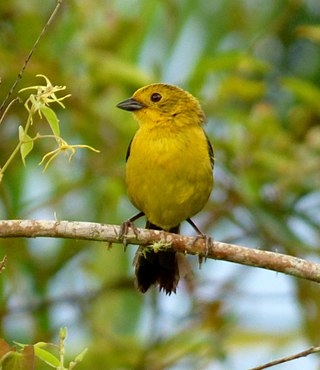
The Irish Museum of Modern Art, also known as IMMA, is Ireland's leading national institution for the collection and presentation of modern and contemporary art. It is located in Kilmainham, Dublin.

The verdin is a species of penduline tit. It is the only species in the genus Auriparus and the only representative of the old world family Remizidae to be found in North America.

The buffy-headed marmoset is a rare species of marmoset endemic to the rainforests of south-eastern Brazil. It occurs in southern Espírito Santo and possibly northern Rio de Janeiro and its distribution extends into Minas Gerais.

Rhodacanthis, commonly known as the koa finches, is an extinct genus of Hawaiian honeycreeper in the subfamily Carduelinae of the family Fringillidae. All four species were endemic to Hawaii.

The yellow-headed brushfinch is a Near Threatened species of bird in the American sparrow family, Passerellidae. It is endemic to Colombia. The common name is a semi-literal translation of the scientific name, with Atlapetes referring to the brushfinch genus, and flaviceps meaning "yellow-headed".

Imma is a large genus of moths in the obtectomeran "micromoth" family Immidae. This is the type genus of its family. They are widespread in the tropics, with most species occurring between the Himalayas and the Oceanian region; the genus is furthermore plentiful in the Neotropics, but not very diverse in the Afrotropics.

The Ministry of Foreign Affairs is the Andorran government ministry which oversees the foreign relations of Andorra.

"Imma Put It on Her" is the first single from the American R&B boy band Day26's second studio album, Forever in a Day. It features Diddy and Yung Joc. Willie Taylor, Robert Curry, & Que share lead vocals, with Brian Angel and Big Mike providing ad libs.

"Imma Be" is a song by the American group the Black Eyed Peas from their fifth studio album The E.N.D. (2009). The song's title is a slang expression, meaning "I am going to be" or "I will be". Initially released as a promotional single, the song went on to receive a full release as the fourth single from The E.N.D. on January 12, 2010, by Interscope Records.

"Imma Star (Everywhere We Are)" is a song by the American R&B recording artist Jeremih. It is the second single released from his first album, Jeremih. The music video was released in July 2009 and was directed by Marc Klasfeld.

Vespula flaviceps is a species of social wasp in the genus Vespula. It found in Eastern Asia and Japan. Studies have suggested that the queens of this species may mate with more males and use sperm more evenly. The reason for this is not yet well understood.

The red-headed krait is a large highly venomous elapid snake with dramatic coloration. The red-headed krait can grow to a length of up to 2.1 metres (7 ft). It lives in lowland rain forest, including those on islands, but it is considered uncommon. It feeds primarily on specific snakes, probably semiaquatic and fossorial snakes. In Southeast Asia, the red-headed krait occurs in Malaysia, Singapore, Thailand and Indonesia (Sumatra), with a subspecies in Borneo. The venom potency is little-studied, as bites from this species are extremely rare.

Uracentron flaviceps, the tropical thornytail iguana or Amazon thornytail iguana is an elusive species of medium-sized arboreal lizard found in the tropical lowlands of the Amazon Rainforest. The species was described by French zoologist Alphone Guichenot in 1855. They are considered to be ant specialists and exhibit communal nesting and a harem-style breeding system in which one male mates with and attends to multiple females. Study of this species has been impeded by difficulties collecting and observing them.

Bamakhyapa, born Bamacharan Chattopadhyay, was an Indian Hindu saint who resided in Tarapith and whose shrine is also located in the vicinity of the Tara temple in Birbhum. He was born at Atla village in the Rampurhat subdivision of the Birbhum district.
Hyphorma flaviceps is a moth of the family Limacodidae. It is found in India and Vietnam.
Rhipidarctia flaviceps is a moth in the family Erebidae. It was described by George Hampson in 1898. It is found in Cameroon, the Democratic Republic of the Congo, Equatorial Guinea, Nigeria and Togo.
Rhabdophis flaviceps, the orangeneck keelback, orange-lipped keelback, or yellow-headed keelback, is a species of snake in the family Colubridae. It is found in Indonesia, Thailand and Malaysia.

Pelegrina flaviceps is a species of jumping spider in the family Salticidae. It is found in the northeastern United States and southeastern Canada.
Diploderma flaviceps, the Szechwan japalure, is endemic to China.














